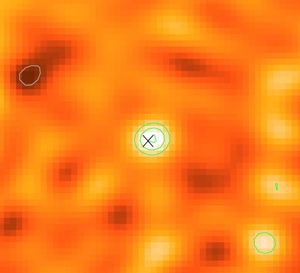Jul 9 2014
Astronomers have studied the carbon monoxide in a galaxy over 12 billion light years from Earth and discovered that it’s running out of gas, quite literally, and headed for a ‘red and dead’ future.
 Radio waves emitted from ALESS65 as observed by the Australia Telescope Compact Array. Credit: Huynh et al.
Radio waves emitted from ALESS65 as observed by the Australia Telescope Compact Array. Credit: Huynh et al.
The galaxy, known as ALESS65, was observed by the Atacama Large Millimeter Array (ALMA) in 2011 and is one of less than 20 known distant galaxies to contain carbon monoxide.
Dr Minh Huynh from The University of Western Australia node of the International Centre for Radio Astronomy Research (ICRAR) led the team on their search for galactic carbon monoxide in work published today in the Monthly Notices of the Royal Astronomical Society.
“We’re familiar with carbon monoxide here on Earth as the deadly gas that can cause suffocation, but in galaxies it plays an important role in the lifecycle of stars,” said Huynh.
“Out of the galaxies that we know contain carbon monoxide, less than 20 are as far away from Earth as ALESS65. Out of the billions of galaxies out there, the detections are very rare!”
Huynh, who grew up in Perth, said that at first astronomers didn’t think there could be massive ‘red and dead’ galaxies in the distant Universe, so studying galaxies heading towards that fate is important to solve the puzzle of their existence.
Using the Australia Telescope Compact Array (ATCA) radio telescope in NSW, Australia, Huynh and the team worked out how much carbon monoxide they could see in ALESS65 and extrapolated that out into how much fuel the galaxy has left – how much gas it has.
“All galaxies have a certain amount of fuel to make new stars,” said Huynh.
“Our galaxy, the Milky Way, has about five billion years before it runs out of fuel and becomes ‘red and dead’, but ALESS65 is a gas guzzler and only has 10s of millions of years left – very fast in astronomical terms.”
The team also combined their observations of the galaxy with the original data from ALMA to work out how similar ALESS65 is to galaxies nearer to Earth.
“We were able to work out the strength of the UV radiation in ALESS65; it’s similar to some ‘starbursting’ galaxies in the local universe, but the stars in ALESS65 are forming in much larger areas when compared to local galaxies,” said Huynh.
The team will now turn their attentions to the search for carbon monoxide in another galaxy near to ALESS65, named ALESS61.
“Finding and studying carbon monoxide in more galaxies will tell us even more about how stars formed in the early days of the Universe and help solve the mystery of far away ‘red and dead’ galaxies” said Huynh.
ICRAR is a joint venture between Curtin University and The University of Western Australia with support and funding from the State Government of Western Australia.
Original Publication
“Detection of molecular gas in an ALMA [CII]-identified Submillimetre Galaxy at z=4.44” Huynh et al. Monthly Notices of the Royal Astronomical Society (Oxford University Press), Published 9th of July 2014. Available at: http://mnrasl.oxfordjournals.org/lookup/doi/10.1093/mnrasl/slu077 (Pre press copy: http://arxiv.org/abs/1407.0463).